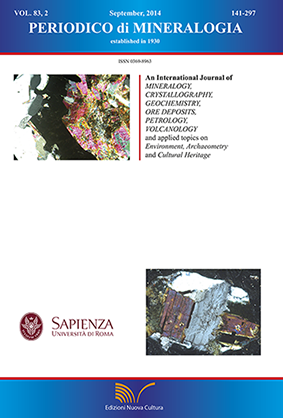PT-path reconstruction via unraveling of peculiar zoning pattern in atoll shaped garnets via image assisted analysis: an example from the Santa Lucia del Mela garnet micaschists (northeastern Sicily-Italy)
DOI:
https://doi.org/10.2451/2014PM0015Keywords:
X-Ray Map Analyzer, thermodynamic modeling, Perple_X, Southern Calabrian Peloritani OrogenAbstract
Garnet micaschists nearby Santa Lucia del Mela - Peloritani Mountains (North-eastern Sicily, Italy), were studied by integrating information obtained from petrographic and image-assisted analyses of mineral phase compositions by using X-ray maps and thermodynamic modeling. These rocks are characterized by the presence of atoll garnets, and preserve a continuous array of textures from pristine garnets, through peninsula or island textures, to atoll textures. Completely substituted garnets represent the final stage of the process. These textures result from the metamorphic evolution of the rocks, consisting of two main stages of recrystallization-deformation events. The sequence of mineral parageneses associated to successive deformation events is as follows: early D1 is characterized by the assemblage wm1 + chl1 + bt1 + pl1 + grt1 + qtz + ilm + ap; late D1 by grt2 + wm2 + chl2+ bt2 + pl2 + qtz + ilm + ap + hem; D2 (associated to garnet core transformation) by grt3 + bt3 + pl3 + wm3 + qtz + chl3 + ilm. On the basis of textural observations and mineral parageneses, the atoll formation is related to the substitution of garnet cores during the D2 stage, with the consumption of garnet cores (grt1) and production of new garnet rim (grt3) with wm, bi, qtz and pl. The recognition of the different stages of garnet growth and associated parageneses has been obtained using image analysis coupled with compositional maps, performed via multivariate statistical analysis of four selected X-Ray map arrays. Following the textural and mineral-chemical analyses, PT conditions associated to the three recrystallisation stages have been determined via pseudosection computations. Results indicate that the analyzed rock-types have recorded a clock-wise PT trajectory during the Variscan orogeny, defined by a prograde evolution, in amphibolite facies conditions, preserved in relic garnet cores, followed by an initial decompressional evolution toward lower amphibolite facies conditions associated to a partial heating. During this last stage the multi stadial atollization process took place, retrogradely evolving toward a green-schist facies conditions, constrained through the compositions of the pseodomorphyc mineral aggregates gradually substituting previously formed garnets.


